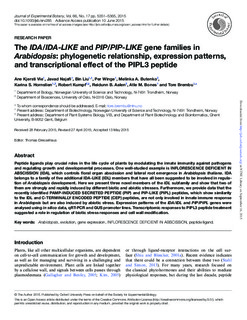| dc.contributor.author | Vie, Ane Kjersti | |
| dc.contributor.author | Najafi, Javad | |
| dc.contributor.author | Liu, Bin | |
| dc.contributor.author | Winge, Per | |
| dc.contributor.author | Butenko, Melinka Alonso | |
| dc.contributor.author | Hornslien, K | |
| dc.contributor.author | Kumpf, Robert | |
| dc.contributor.author | Aalen, Reidunn B. | |
| dc.contributor.author | Bones, Atle M. | |
| dc.contributor.author | Brembu, Tore | |
| dc.date.accessioned | 2015-10-14T10:58:31Z | |
| dc.date.accessioned | 2015-10-21T11:22:43Z | |
| dc.date.available | 2015-10-14T10:58:31Z | |
| dc.date.available | 2015-10-21T11:22:43Z | |
| dc.date.issued | 2015 | |
| dc.identifier.citation | Journal of Experimental Botany 2015, 66(17):5351-5365 | nb_NO |
| dc.identifier.issn | 1460-2431 | |
| dc.identifier.uri | http://hdl.handle.net/11250/2357492 | |
| dc.description.abstract | Peptide ligands play crucial roles in the life cycle of plants by modulating the innate immunity against pathogens and regulating growth and developmental processes. One well-studied example is INFLORESCENCE DEFICIENT IN ABSCISSION (IDA), which controls floral organ abscission and lateral root emergence in Arabidopsis thaliana. IDA belongs to a family of five additional IDA-LIKE (IDL) members that have all been suggested to be involved in regulation of Arabidopsis development. Here we present three novel members of the IDL subfamily and show that two of them are strongly and rapidly induced by different biotic and abiotic stresses. Furthermore, we provide data that the recently identified PAMP-INDUCED SECRETED PEPTIDE (PIP) and PIP-LIKE (PIPL) peptides, which show similarity to the IDL and C-TERMINALLY ENCODED PEPTIDE (CEP) peptides, are not only involved in innate immune response in Arabidopsis but are also induced by abiotic stress. Expression patterns of the IDA/IDL and PIP/PIPL genes were analysed using in silico data, qRT-PCR and GUS promoter lines. Transcriptomic responses to PIPL3 peptide treatment suggested a role in regulation of biotic stress responses and cell wall modification. | nb_NO |
| dc.language.iso | eng | nb_NO |
| dc.publisher | Oxford Open | nb_NO |
| dc.relation.uri | http://jxb.oxfordjournals.org/content/early/2015/06/09/jxb.erv285.long | |
| dc.title | The IDA/IDA-LIKE and PIP/PIP-LIKE gene families in Arabidopsis: phylogenetic relationship, expression patterns and transcriptional effect of the PIPL3 peptide | nb_NO |
| dc.type | Journal article | nb_NO |
| dc.type | Peer reviewed | en_GB |
| dc.date.updated | 2015-10-14T10:58:31Z | |
| dc.source.volume | 66 | nb_NO |
| dc.source.journal | Journal of Experimental Botany | nb_NO |
| dc.source.issue | 17 | nb_NO |
| dc.identifier.doi | 10.1093/jxb/erv285 | |
| dc.identifier.cristin | 1241044 | |
| dc.description.localcode | © The Author 2015. Published by Oxford University Press on behalf of the Society for Experimental Biology. This is an Open Access article distributed under the terms of the Creative Commons Attribution License (http://creativecommons.org/licenses/by/3.0/), which permits unrestricted reuse, distribution, and reproduction in any medium, provided the original work is properly cited. | nb_NO |
